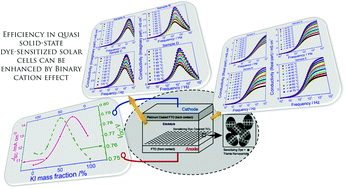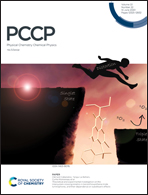Binary counter ion effects and dielectric behavior of iodide ion conducting gel-polymer electrolytes for high-efficiency quasi-solid-state solar cells
Abstract
A series of highly efficient quasi-solid-state dye-sensitized solar cells (DSCs) is prepared by harnessing the binary cation effect and positive effects of the selected performance enhancers of gel-polymer electrolytes. The new electrolyte is composed of polyacrylonitrile polymer, tetra-hexylammonium iodide (Hex4NI) and KI binary salts as well as 4-tertbutylpyridine and 1-butyl-3-methylimidazolium iodide performance enhancers. The charge transport in the series of electrolytes is thermally activated and, accordingly, the temperature dependence of conductivity follows the VTF behavior. The enhancement of conductivity is observed with an increasing mass fraction of KI and decreasing mass fraction of Hex4NI, while the total mass fraction of salts in the electrolyte is kept unchanged. The highest conductivity of 3.74 mS cm−1 at ambient temperature is shown by the sample containing KI only (without Hex4NI) at all the temperatures. The effects of dielectric polarization of the electrolytes are studied by analyzing the frequency dependence of the real and the imaginary parts of the AC conductivity in detail. Appropriate and reproducible cell construction are assured by efficiencies of above 5% exhibited by all the quasi-solid-state DSCs assembled using double-layered TiO2 photo-electrodes and the new electrolyte series. Besides, highlighting the mixed cation effect, the cells with mixed salts exhibited efficiencies greater than 6%. An impressively high efficiency of 7.36% was shown by the DSC prepared with electrolyte containing 75 wt% KI and 25 wt% Hex4NI. This study reveals that the salt combination of KI and Hex4NI, which has not been reported before, is a suitable binary iodide salt mixture to prepare highly efficient DSCs. The replacement of tetra-hexylammonium ions by K+ ions improves the charge transport in the electrolyte; however, the best solar cell performance is shown by the mixed salt system with 75 wt% KI and 25 wt% Hex4NI, which is not the highest conductivity composition. Therefore, the exhibited high efficiency of 7.36% is evidently due to the binary cation effect.



 Please wait while we load your content...
Please wait while we load your content...